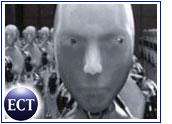
In previous columns, I’ve described the benefits of transportable music files, especially for getting your music heard [Paul Korda, “Kissing Big Music Goodbye: Diary of an Online Musician,” TechNewsWorld, April 7, 2004]. To balance the virtues of such thinking, one must ask oneself whether the method of digital sampling and recording — or even, for that matter, digital video — is really capturing the essence of the matter being recorded.
Of course, this question has been a topic of conversation in the entertainment industry ever since digital recording came into being, but the assessment of the state of digital must always be a subject of research, for art and science both need to move forward equally so that both can benefit.
The slogan “state of the art” should not just apply to electronic devices. In fact, art — whether it is musical, visual, technical or even medical — comes from spiritual, emotional and mental needs first. The machine comes after.
Natural, by Design
Even though it might seem like blowing one’s own horn, we all should admit that the greatest machines ever built in the history of the Earth were designed by Nature — taking millions of years. The way our ears and eyes sample reality goes beyond the digital recording mechanism.
The way a piano or any other instrument sounds has — in its perfection — a flaw. That is, when strings are struck by hammers, they vibrate in the normal sound of a note that we hear as the loudest part. But beyond the main note, there are harmonics vibrating far beyond our ability to hear them.
Often, these harmonics are quite untuned. But at the same time, their imperfection introduces the character of the piece. I have always felt that in the art of songwriting, these harmonics are connected to the subconscious, or “felt,” areas of the psyche.
They are akin to hidden signposts on a road that leads the creator to the magic of the language of feeling. You feel them more than hear them. Great writing and playing have always placed feel as the criteria for greatness in any work of art, be it film, music or anything worthwhile, including relationships.
Blind to the Future
While we are all rushing into the excitement of the digital future, we must be concerned that the research going into the framework does not forget feel. If we do, we might blind ourselves to a future of gradually more limited expression because of a lessening of feel.
Let’s not forget that we are passing this framework to our children, and unless we see what is necessary for feel to be measured better in digital recording, we could be missing an important element in the future of art. And any poverty in the system should be recognized in our rating of where technology is at right now.
That’s about as logical as I’m going to get about feeling, which, as we know, often defies logic.
Feeling and Warmth
In the former methods of recording, magnetic particles of iron make millions of atoms attract and repel in myriad ways, and hold a reflection of the artist’s vision. In the case of film, silver nitrates perform a similar dance on their foundation of plastic, each capturing the opposites of dark and light in shades so subtle that warmth is apparent.
Feeling is often equated with warmth. Many practitioners of the audio art form have complained in the past that digital recording lacks warmth. Well, one might say that the Earth right now, apart from global warming, lacks warmth, and perhaps a little analog in relationships could be welcome.
Seriously, though, if digital piano is better than a Steinway or Yamaha grand, why would orchestras and studios alike use acoustic?
Obviously, our ears know better, yet the positive side of digital is that the beautiful-sounding acoustic — at least a sampled version of it — can be played by all for a small price.
Digital Revolution
You might by now think that I am not for the digital revolution, but if you read my former columns, you would know that I am totally for it. The obvious benefits of editing — and the size of equipment — need no space in this column. What I mean to draw your attention to here is the state of the Art.
Ask yourself if much of the digitally produced contemporary genres lack warmth, both musically and sonically. I leave it to you to answer.
Maybe the next time you begin a song, try using an acoustic instrument first. You can always go to digital later. See if there is more feeling to your song. If Beethoven were here, he could answer with some of his work, for he felt music, as he was deaf.
Roll over, Beethoven.
Paul Korda’s new album “Not for Robots” is available online at PaulKorda.com. His songs have been recorded and sung by Roger Daltrey, Frankie Valli, Dave Edmunds, Allan Holdsworth, Robert Palmer, Italy’s Patty Pravo and many others, with sales in excess of 20 million copies.













































